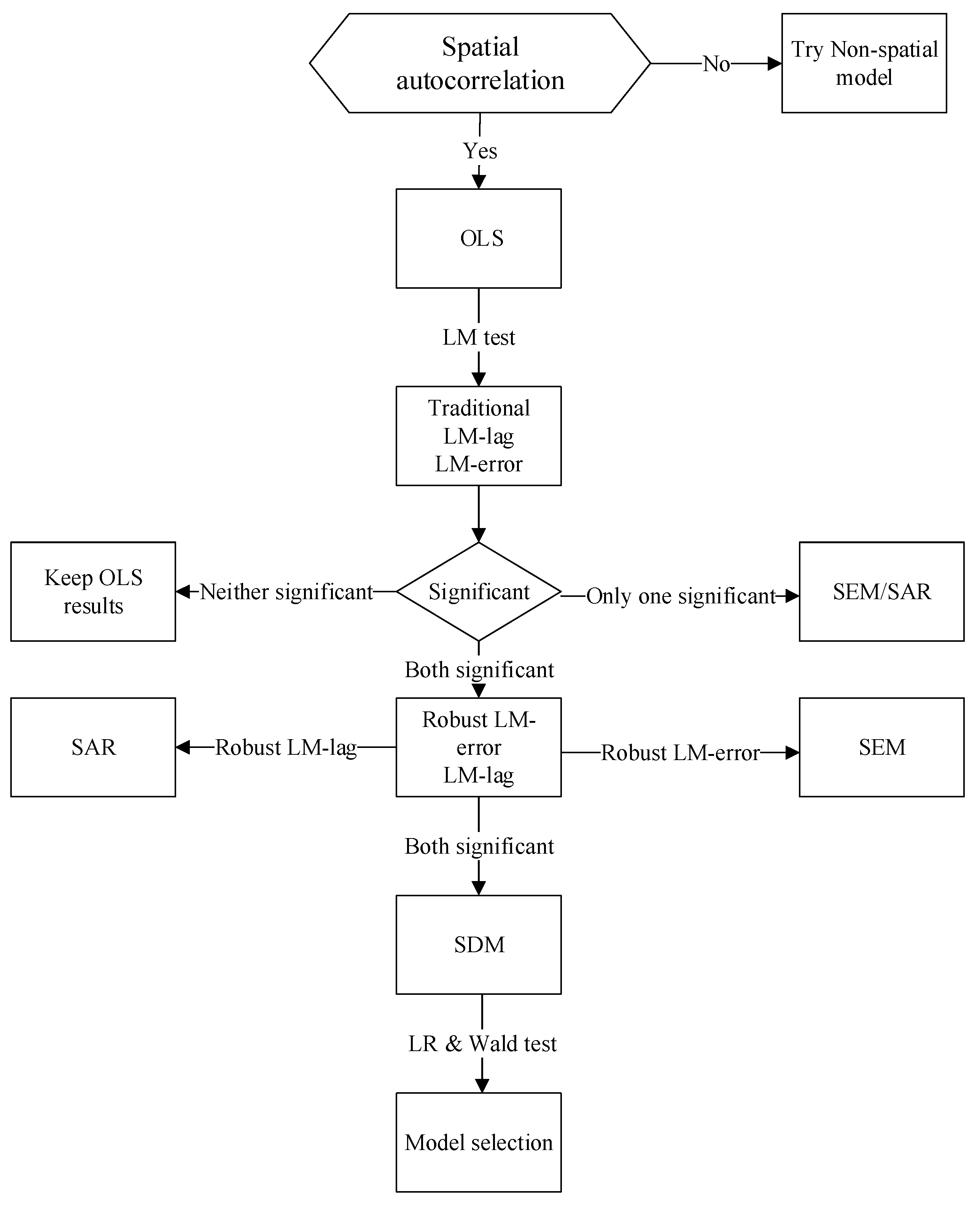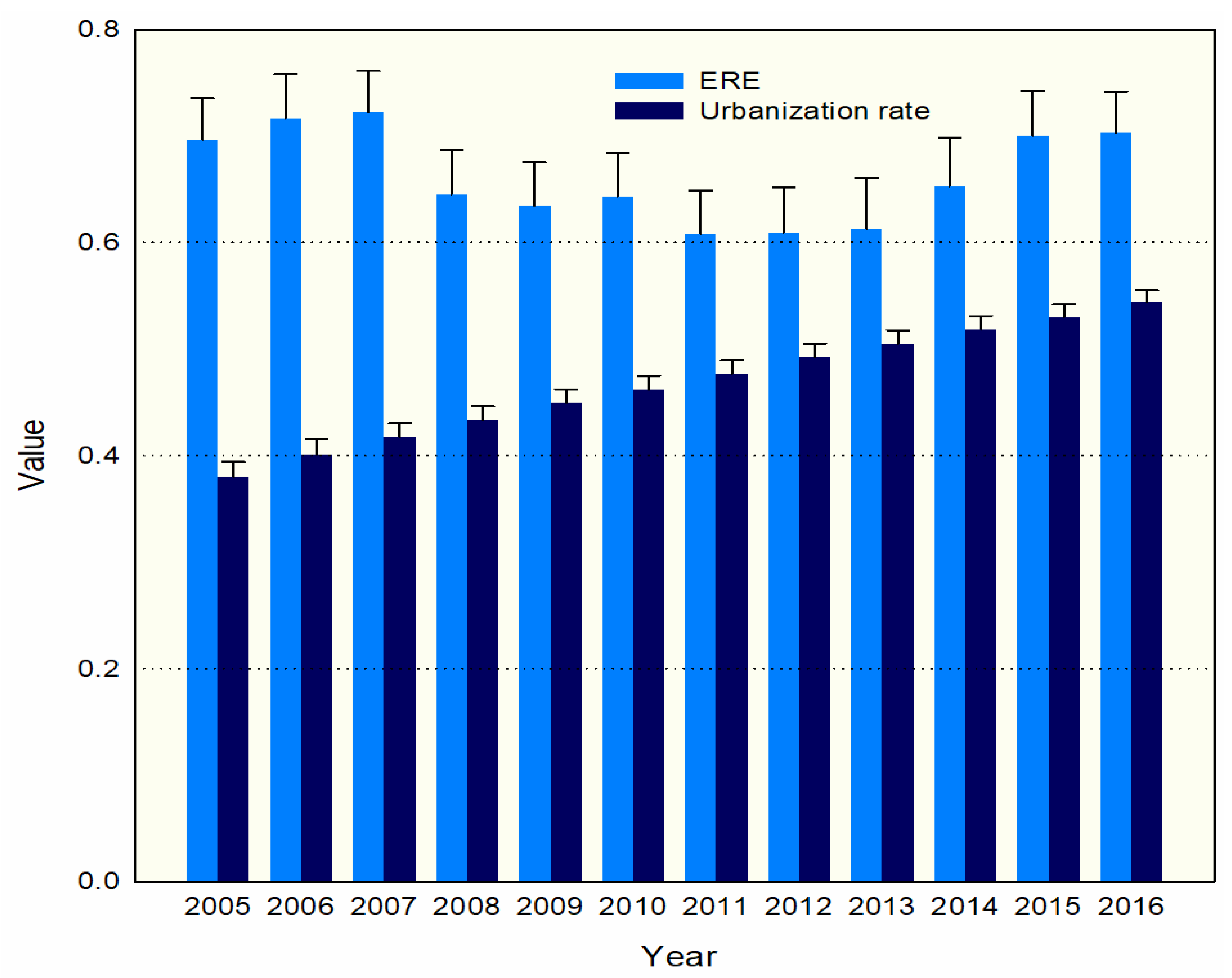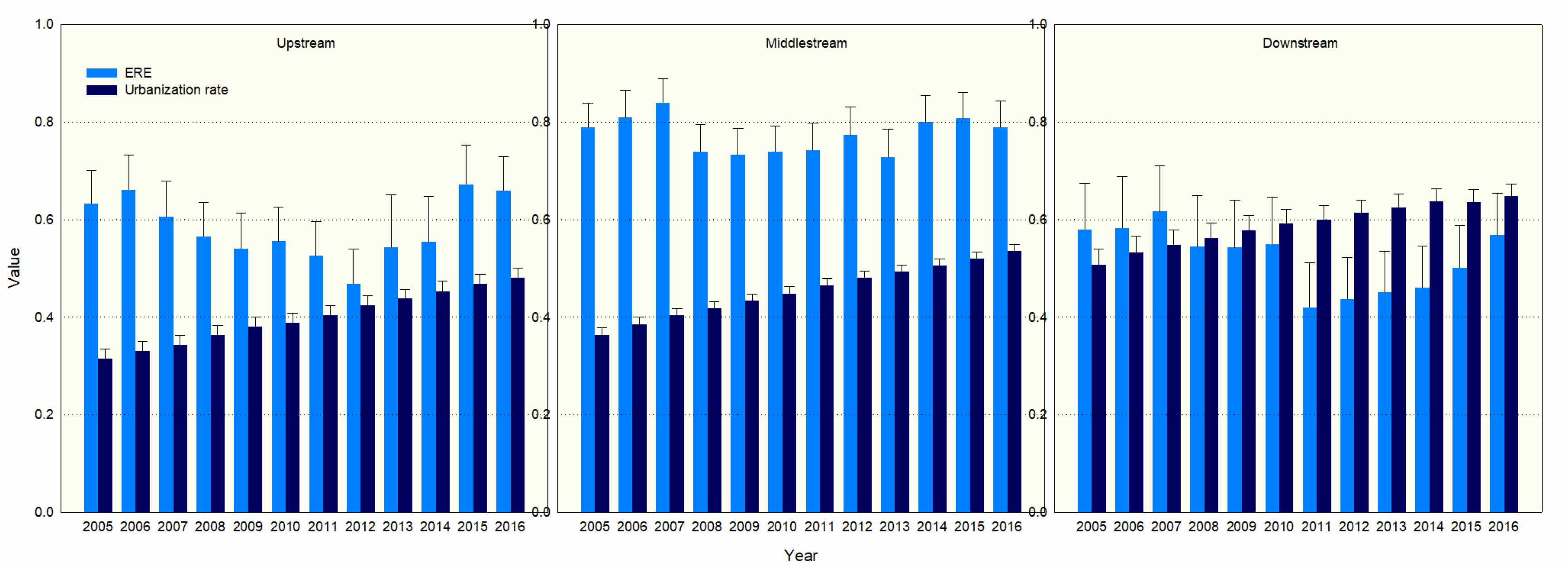1. Introduction and Background
In 2021, the Chinese Ministry of Finance and other departments jointly issued the Implementation Plan for Supporting the Establishment of a Horizontal Ecological Protection and Compensation Mechanism for the entire Yangtze River Basin [
1], where the main goal was to improve the ecological environment of the Yangtze River Basin (YRB). Consequently, the National Development and Reform Commission issued the Key Tasks for New Urbanization and Urban−Rural Integration Development in 2021 [
2]. This policy is geared towards advancing a new urbanization strategy centered on people, strengthening the construction of metropolitan areas, using central cities to drive neighboring cities, and accelerating the process of intra-urbanization. For example, Ge et al. [
3] found that only by improving the efficiency of environmental control can the inclusive growth of local and neighboring economies be promoted. This result was based on the panel data of 281 cities in China from 2004 to 2016 and the two-region spatial Durbin model (SDM). Yu et al. [
4] estimated the industrial ecoefficiency of 30 provinces in China from 2001 to 2015 based on the data envelopment analysis method. The authors verified the spatial convergence of industrial ecoefficiency through utilizing dynamic spatial econometrics. There is clear heterogeneity both in time and space. In the analysis of the influencing factors of environmental pollution, economic development and environmental pollution present an inverted N-shaped relationship. While industrial structure, technological research, and development all strongly affected environmental pollution, it was identified that foreign direct investment, by contrast, only minutely affected the environment [
5]. The development of clean technologies should be strongly supported, because well-designed environmentally friendly policies could protect the environment and boost economic growth [
6].
Tang et al. [
7] argued that effective adjustment between land urbanization and urban ecological efficiency can promote sustainable economic development based on the mediating effect model. Land urbanization is not a simple inhibitory effect on ecological efficiency, but instead possesses a U-shaped relationship. The negative impact of land urbanization in northern prefecture-level Chinese cities on ecological efficiency is higher than that in southern cities. The establishment of urban agglomerations is an important sign of urbanization. During the process of urbanization, pollution emissions will be aggravated [
8]. If the environment fails to receive adequate protection, economic development will be retarded while the process of urbanization would further aggravate environmental degradation. Fortunately, ecological innovation has been shown to stimulate the sustainable development of urbanization [
9]. Human capital can also slow down the deterioration of the environment caused by the urbanization expansion [
10]. The urbanization rate increases the domestic waste, and there is an inverted U-shaped relationship with the discharge of industrial pollutants [
11].
Chen et al. [
12] analyzed the impact of multidimensional urbanization on carbon emissions through a spatial panel model. The direct impact of population, land, and economic urbanization is positive, but the indirect impact of population urbanization is negative. Xing et al. [
13] used data from 340 Chinese cities from 2000 to 2015 and employed a spatial panel measurement model to analyze the relationship between urbanization and the value of ecosystem services from the three dimensions of land, population, and economic urbanization. The land urbanization and economic urbanization of China can effectively improve the ecosystem services of surrounding cities. However, the urbanization of population has a negative impact on the surrounding ecological environment. Liang et al. [
14] used geographic and time-weighted regression models to identify that reductions in environmental pollution are mainly due to the improvement of education and service industry levels, in addition to the increase of fiscal revenue and the popularization of the Internet. The urbanization rate, population agglomeration, economic development, industrial upgrading, urban construction, and transportation construction have all intensified environmental pollution. Urbanization has improved the environment in mountainous areas, but it has intensified pollution in plains and coastal areas. Therefore, a reasonable urban growth management policy is particularly important. An effective combination of urban development and environmental resource governance can avoid negative impacts on resources and the environment due to urban expansion [
15]. Wu et al. [
16] used a dynamic threshold panel model to analyze the interaction between urbanization and environmental pollution. Environmental pollution hinders the development of urbanization of the population but promotes the urbanization of the living environment. Rapid urbanization has indeed destroyed the structure and function of the ecosystem. Based on a study on the county level in Chongqing from 1997 to 2015, using time−space weighted regression (GTWR), it was found that population urbanization has exacerbated the deterioration of the natural ecosystem. The deterioration of the natural environment will also inhibit the sustainable development of urbanization [
17].
Lv et al. [
18] analyzed panel data from 30 Chinese provinces from 1997 to 2016 and concluded that in the process of rapid urbanization, energy efficiency needs to be improved and industrial structure be upgraded. China’s environmental pollution has the characteristics of spatial agglomeration with the high level of local urbanization, which will have side effects on the local environmental quality. Zhang et al. [
19] used SDM to analyze the impact of urbanization on carbon dioxide emissions from two aspects of population urbanization and land urbanization. They found that while population urbanization has both positive and significant spatial spillover effects, these effects are virtually nonexistent for land urbanization. China’s population urbanization indicators have a large regional gap, but from 1995 to 2018, China’s ten largest urban agglomerations all experienced rapid urbanization development. With the exception of Beijing−Tianjin−Hebei and Sichuan−Chongqing urban agglomerations, the carbon storage of all others is in decline [
20]. Population urbanization promotes carbon emissions [
21]. Li et al. [
22] used frontier stochastic models to estimate the energy efficiency of 30 Chinese provinces from 2003 to 2014 and analyzed the spatial dependence of energy efficiency using a spatial panel data model. The impact of urbanization on energy efficiency is not only reflected in the direct negative effects, but also in the spatial spillover effects brought about by the urbanization of neighboring areas. Excessive urbanization has indeed brought about an increase in pollution, mainly due to economic and human activities [
23]. Although rapid urbanization has promoted economic development, it has seriously threatened the improvement of the ecological environment. From 2008 to 2017, the level of urbanization in China increased, but the efficiency of the ecological environment declined [
24]. Regions and countries with higher levels of urbanization will pay more attention to coordinated development with the ecological environment. There is a certain coupling relationship and path dependence between urbanization and environment development. Studying the problems of urbanization and environmental regulation efficiency can provide decision-makers with reference for sustainable development and environmental protection [
25].
The purpose of this article is to examine the impact of urbanization in the Yangtze River Basin on the efficiency of environmental regulations, as well as what changes will occur in the impact of such agglomeration on the efficiency of environmental regulations once resource carrying capacity is taken into account. Will urbanization be able to adequately safeguard the environment without compromising economic development if government policies change? This article’s main goals are to (1) study the impact of urbanization on environmental regulations in a systematic way and identify important contributing factors, and (2) construct appropriate static and dynamic spatial econometric models. It is desired that suitable recommendations are made to decision-makers so that the urbanization process may not only assure economic growth but also preserve environmental development.
This paper is structured as follows. After this introduction and background section,
Section 2 presents the methodology, including the research area, econometric models, and data description.
Section 3 analyzes the estimation results and effects decomposition.
Section 4 examines the robustness check with three different methods, including core variable replacement, dynamic spatial econometric model, and time periods decomposition. In
Section 5, we draw the main conclusions, and discuss the limitations of this paper and possible future research directions.
5. Conclusions and Discussion
In the analysis of the effects of population urbanization rate on environmental regulation efficiency in 97 cities in the YRB from 2005 to 2016, the overall efficiency of environmental regulation in the YRB is not high, and there are large differences between different regions. The overall development of ERE presents a smiling curve trend. The urbanization rate of the population is showing a continuous growth trend. Compared with developed countries, the urbanization rate still has a lot of room for improvement. Overall, the urbanization rate and the efficiency of environmental regulations have not shown a trend of simultaneous growth. After 2011, however, the efficiency of environmental regulations in the lower reaches of the Yangtze River has shown a trend of simultaneous growth. This paper used Moran’s index and Elhorst LM test to verify the existence of the spatial autocorrelation relationship of ERE in the YRB. It was verified that the increase in population urbanization inhibits the increase in the efficiency of environmental regulation. Promoting a shift of the population from being agriculture-focused to one that engages in more activities will likely have a negative effect on environmental regulations. A U-shaped relationship between economic agglomeration and the efficiency of environmental regulation was also observed. After decomposing the spatial effects and fully considering the impact of urbanization, economy, society, and resource environment on the efficiency of environmental regulations, it was found that these factors will not only affect the local area, but also affect the surrounding cities, and the impact on the surrounding cities will eventually even feed back into itself. In terms of direct effects, urbanization and environmental regulation efficiency are negatively correlated, and the environmental Kuznets curve hypothesis has not been verified. The development of the secondary industry and the investment in fixed assets have a negative impact on the local environment. Increasing the employment rate can effectively improve the efficiency of environmental regulation. The increase in FDI will bring about capital growth, innovative products, and technologies, alleviate the problem of rising costs caused by environmental regulation, and ultimately improve the efficiency of environmental regulation. In terms of resources, the more abundant the water resources and forestry resources, the higher the efficiency of local environmental regulations. The spatial effect of the urbanization rate is negative, but not significant. In the overall effect, the relationship between the two variables is still a significant negative correlation.
Urbanization can promote the structural transformation of the economy, and it is also an important driving force for the structural transformation of the economy. However, to pursue higher regional GDP and taxation, local governments will have excessive preference for industrial enterprises and physical investment when formulating and implementing economic policies. Therefore, public investment in human capital, such as education, is seriously insufficient. However, with the development of China’s economy, economic restructuring has gradually changed to take the people’s pursuit of a better life as the basic law. In 2013, China again began to promote urbanization again. Although urbanization is developing very rapidly, China remains below the average level of developed countries as seen from the perspective of population urbanization. As the YRB plays a vital role in China’s economic development, urbanization is an important driving force for expanding domestic demand. In the process of promoting urbanization, too much attention is paid to speed and quantity, which brings many unsustainable risks to economic development. Urbanization cannot only be measured by population size. It should also focus on matching urbanization with the carrying capacity of resources and the environment. Only by gradually shifting from the pursuit of quantity to the pursuit of high-quality urbanization can real sustainable development be achieved.
This article does have limitations. The degree of urbanization in developed countries is much higher than that in China, and there are large differences in basic national conditions. Perhaps the research results do not apply to those developed countries at present. However, there are still many developing countries, such as countries along the Belt and Road Initiative and other low-income countries. Urbanization is one of the important driving forces of economic development. The development of urbanization will inevitably lead to the development of industrialization, and then the development of industrialization will, to a large extent, give rise to environmental problems. Well-designed policies will play a very important guiding role. Therefore, in the process of urbanization, how to coordinate the economy and the environment, as well as how to exert the space radiation effect of cities, are issues that need to be continuously discussed. In the context of global warming and carbon neutrality, maintaining sustainable economic development without sacrificing the ecological environment is an issue worthy of study. Despite the limitations of the article, the results do suggest that simply pursuing excessive growth will bring certain damage to the ecological environment. In the process of economic growth, resource carrying capacity needs to be considered, and reasonable policies can effectively improve ERE. In future research, we will focus on the agglomeration phenomenon and further explore the transmission mechanism on sustainable economic development. Furthermore, we will explore how this agglomeration phenomenon is conducive to the realization of the great vision of global carbon neutrality.
In the formulation of policies, we should not blindly aim to increase the urban population but should instead correctly guide population flows in the process of urbanization. The government should therefore fully consider the carrying capacity of economic and social activities. Moreover, the government should advocate the formulation of a new type of urbanization, stabilize employment, expand the opening to the outside world, realize industrial transformation and upgrading, and strengthen the protection of natural resources to promote sustainable green economic development.










